Hints and Teasers
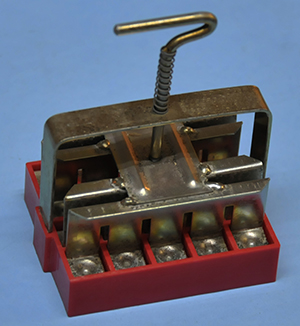
Helpful Hints 2
by Lew Buller
Making fertilizer, Annealed copper wire, Wood blocks for planting angles, Making a turntable, Reusing soil
Making fertilizer
Cottonseed meal is an excellent organic fertilizer with a makeup of 5-2-1. Some advertised cottonseed meal has higher NPK numbers, possibly due to the addition of blood meal. A problem occurs when you put it directly on the soil around your plants. It breaks down with watering, becomes fine, and works its way down into the soil. The solution? Make your own cottonseed meal cakes that do not break down into fines.
The recipe is simple–cottonseed meal and water plus any additives like blood meal that you want to build in. If you include additives, there is almost no way you can calculate the revised NPK ratio. It’s trial and error, so include additives in small amounts until you know how they work.
One gardeners’ tool is all you need and it will pay for itself quickly. It’s a soil blocker (used to create small cubes of soil that will hold one seed) to form the cubes of fertilizer.
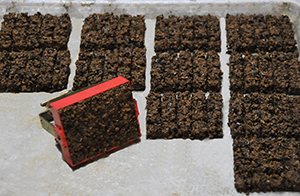
Add water slowly to the cottonseed meal. The meal takes some time to absorb water and the less that is added, the quicker it will dry. Just enough water to make a firm cube. A word of warning; the cubes begin to smell strongly as they ferment to release the elements. I make mine on an old baker’s pan and dry them in the garage, under my truck, taking care to tell my wife that the garage will stink for about 3 weeks. When they are dry, they still should be handled with some care as you don’t want to break them.
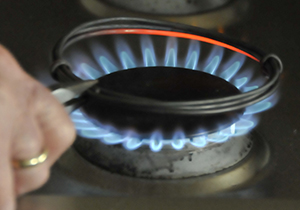
Wire Glows a Cherry-Red
Annealed copper wire
Copper wire was very scarce and expensive when it was first used by Japanese masters. They learned to remove it by unrolling it rather than cutting it off, straighten it with wooden hammers, and anneal it in rice straw fires. The rice straw fires heated the copper to a cherry red that is sufficient for basic annealing. Your kitchen stove will do it, too. Carefully!
Copper anneals at half its melting point of 1,984° F; higher heats cause further softening but there is not much advantage to going above two-thirds of the melting point. Copper wire is also annealed when it is drawn through the dies that determine wire gauge. Different sizes are woven together to get the final size based on the electrical capacity required.
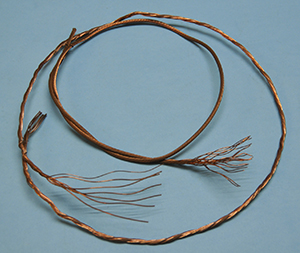
For quite a while I bought left-over wire from a recycling center. Not as soft as heat-softened wire, it was still flexible enough to use on trees and not damage them. The inner coil in the photo has 19 strands of 18 gauge wire and the outer coil has 7 strands of 16 gauge wire. Both are still soft enough to be used on branches, but I also use the 16 gauge to wire plants in pots.
A barbecue grill also works. Smaller gauge wires anneal best; larger gauges (under 12 gauge) would be annealed but hardened some when unwound from the small coils. The smaller the gauge number, the larger the coil should be to avoid hardening the wire when unrolling it. Quenching the annealed wire immediately flakes off the black residue from heating.
Some years ago, having sold a few plants, I used the proceeds to buy a lifetime supply of copper wire at $7.50 a pound. In July, 2014 the lowest price I can find is $12.50 a pound, but the highest runs about $27.50. Shop the Internet carefully; the same supplier that I paid $7.50 to is the one selling it many years later at $12.50, in spite of the rise in the cost of copper.
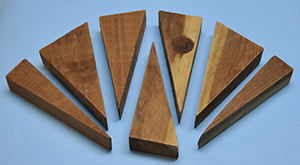
Wood blocks for planting angles
While I can hold a growing pot with a tree in it at an angle to determine the best planting position, I can’t hold it and spin it on a turntable at the same time to be able to look at it from all sides. A scrap piece of 2” x 4” sawed into blocks with different angles makes it possible. Use two blocks of different sizes to tilt the tree off camber and study it until you have picked a front. A small piece of scrap wire can be used to mark it.
Making a turntable
I have an expensive aluminum turntable with a screw stop but it does not meet all my needs. It is easy to make others of different heights and diameters using hardware store turntables and tops from Formica-covered kitchen sink cut-outs or thrift store bargains.
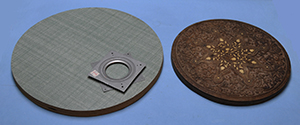
The carved Indian Sheesham wood disk to the right was originally the top to a broken three-legged table in a thrift store. The Formica covered disk is from a cabinet shop, and the small turntable from a hardware store. I used these types of materials to make inexpensive turntables for bonsai club members.
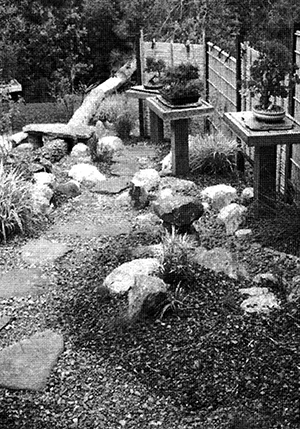
This black-and-white photo appeared in the Journal of Japanese Gardening, No. 23, 2001 “A Unique Solution for a Unique Problem,” page 30, describing a Japanese-style garden my arborist friend and I created for a bonsai lover. Take a look at the monkey poles and you will see they are topped with flat stones. What you will not see are the turntables under the stones that allowed our client to rotate her plants once a week. They are inexpensive turntables from a hardware store. The only caution I have is that the turntables need to be lubricated regularly to prevent rust. Unfortunately, the client’s home was destroyed in a California wildfire that took the garden and bonsai along with it. We made her another garden when she moved into her new home.
Reusing soil
I re-use soil only with considerable care. The concern is two-fold: the possibility of transferring diseases and the fines that occur as the soil breaks down through watering. To deal with the first concern, I sterilize the old soil in the sun (San Diego has plenty of this disinfectant) and the baker’s pans come in handy again, holding 2 ½ gallons of used soil.
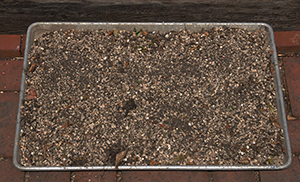
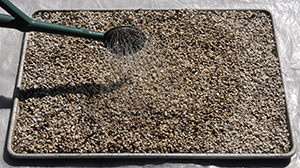
About 1/3 of the mix is broken down organic matter. After sifting the fines out, I disinfect the inorganic material with 3% hydrogen peroxide. For the recycled pumice, I use 2 ½ teaspoons per gallon of water. Potassium permanganate is a superior soil disinfectant–it can be used on bonsai as a soil drench where there is fear of a fungal infection–but hard to choose among the many offerings on the Internet and not readily available locally.
Both release an extra atom of oxygen that kills fungi and/or makes additional oxygen available to the roots.
